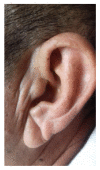The Association between Earlobe Crease (Frank's Sign) and Abnormal Ankle-Brachial Index Determination Is Related to Age: A Population-Based Study
- PMID: 30245883
- PMCID: PMC6139202
- DOI: 10.1155/2018/4735731
The Association between Earlobe Crease (Frank's Sign) and Abnormal Ankle-Brachial Index Determination Is Related to Age: A Population-Based Study
Abstract
Background: Information on the association between earlobe crease (ELC) and peripheral artery disease is limited. We assessed this association in community-dwelling older adults.
Study design: A total of 294 Atahualpa residents aged ≥60 years were enrolled. ELC were visually identified by two raters. The ankle-brachial index (ABI), used as a surrogate of peripheral artery disease, was categorized using American Heart Association criteria. Using logistic regression and probability models, adjusted for demographics and cardiovascular risk factors, we assessed the relationship between ELC and abnormal ABI determinations, as well as the influence of age on this association.
Results: ELC was identified in 141 (48%) individuals, and abnormal ABI determination was carried out in 56 (19%). The association between ELC and abnormal ABI was nonsignificant in logistic regression and probability models with individuals stratified according to their median age.
Conclusions: The association between ELC and abnormal ABI determinations is probably attenuated by the high prevalence of both conditions in older persons. ELC might not be useful for identifying candidates for ABI determination.
Figures


Similar articles
-
The association between earlobe crease (Frank's sign) and cognitive performance is related to age. Results from the Atahualpa Project.Arch Gerontol Geriatr. 2018 Nov-Dec;79:104-107. doi: 10.1016/j.archger.2018.08.008. Epub 2018 Aug 27. Arch Gerontol Geriatr. 2018. PMID: 30179743
-
Earlobe crease may provide predictive information on asymptomatic peripheral arterial disease in patients clinically free of atherosclerotic vascular disease.Angiology. 2014 Apr;65(4):303-7. doi: 10.1177/0003319713479651. Epub 2013 Feb 28. Angiology. 2014. PMID: 23449604
-
The effect of previous strokes on the relationship between ankle-brachial index determinations and incident strokes: A population-based, longitudinal prospective study in older adults.Vascular. 2024 Apr;32(2):412-417. doi: 10.1177/17085381221135890. Epub 2022 Oct 27. Vascular. 2024. PMID: 36303424
-
Diagonal earlobe crease (Frank's sign) and increased risk of cerebrovascular diseases: review of the literature and implications for clinical practice.Neurol Sci. 2020 Feb;41(2):257-262. doi: 10.1007/s10072-019-04080-2. Epub 2019 Oct 23. Neurol Sci. 2020. PMID: 31641899
-
Diagonal Earlobe Crease (Frank's Sign) for Diagnosis of Coronary Artery Disease: A Systematic Review of Diagnostic Test Accuracy Studies.J Clin Med. 2021 Jun 25;10(13):2799. doi: 10.3390/jcm10132799. J Clin Med. 2021. PMID: 34202100 Free PMC article. Review.
Cited by
-
The importance of inspection in clinical cardiology: Frank's sign.Clin Case Rep. 2022 Jul 25;10(7):e6150. doi: 10.1002/ccr3.6150. eCollection 2022 Jul. Clin Case Rep. 2022. PMID: 35898762 Free PMC article.
-
On the association between earlobe crease and the carotid intima-media thickness: A population-based study.Heliyon. 2019 Apr 23;5(4):e01556. doi: 10.1016/j.heliyon.2019.e01556. eCollection 2019 Apr. Heliyon. 2019. PMID: 31049449 Free PMC article.
-
The Relationship between the Presence of an Earlobe Crease and Overactive Bladder: A Cross-Sectional Case-Controlled Study.Medicina (Kaunas). 2023 Feb 28;59(3):476. doi: 10.3390/medicina59030476. Medicina (Kaunas). 2023. PMID: 36984477 Free PMC article.
-
Traditional Cardiovascular Risk Factors Associated with Diagonal Earlobe Crease (Frank Sign) in Mexican Adults: Aging, Obesity, Arterial Hypertension, and Being Male Are the Most Important.Int J Hypertens. 2024 Jun 21;2024:5598134. doi: 10.1155/2024/5598134. eCollection 2024. Int J Hypertens. 2024. PMID: 38948003 Free PMC article.
-
Frank's sign and paired ear creases of the helix : Current concepts of significance for morbidity.Wien Klin Wochenschr. 2022 Mar;134(5-6):237-242. doi: 10.1007/s00508-021-01969-x. Epub 2021 Nov 24. Wien Klin Wochenschr. 2022. PMID: 34817665 Review.
References
-
- Shmilovich H., Cheng V. Y., Rajani R., et al. Relation of diagonal ear lobe crease to the presence, extent, and severity of coronary artery disease determined by coronary computed tomography angiography. American Journal of Cardiology. 2012;109(9):1283–1287. doi: 10.1016/j.amjcard.2011.12.024. - DOI - PubMed
-
- Christoffersen M., Frikke-Schmidt R., Schnohr P., Jensen G. B., Nordestgaard B. G., Tybjærg-Hansen A. Visible age-related signs and risk of ischemic heart disease in the general population: A prospective cohort study. Circulation. 2014;129(9):990–998. doi: 10.1161/CIRCULATIONAHA.113.001696. - DOI - PubMed
-
- Gutiu I. A., Galetescu E., Gutiu L. I. Diagonal earlobe crease: a coronary risk factor, a genetic marker of coronary heart disease, or a mere wrinkle. Ancient Greco-Roman evidence. Romanian Journal of Internal Medicine. 1996;34:217–278. - PubMed
LinkOut - more resources
Full Text Sources
Other Literature Sources

